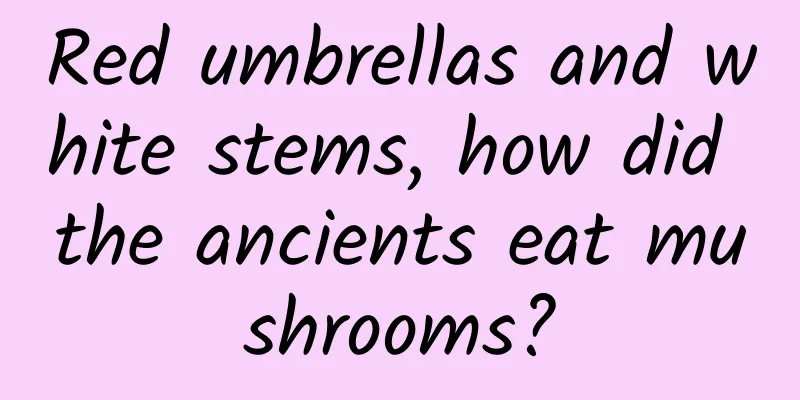Red umbrellas and white stems, how did the ancients eat mushrooms?

|
If you are a web surfing enthusiast, you must have seen it on major platforms recently—— Red umbrella, white pole, lie down on the board together after eating. Lie on a board, sleep in a coffin, and then bury the mountain together. Burying the mountain, crying and shouting, relatives came home for dinner. We had meals and umbrellas, and the whole village lay down together. … This was originally the lyrics of a safety propaganda video produced by relevant departments in Yunnan Province, but it unexpectedly became popular on the Internet and became a brainwashing song for netizens. Since ancient times, people have been tempted by mushrooms. In this country of foodies, the ancients have already served them on the table. Ancient records Nowadays, bacteria, actinomycetes and fungi are generally referred to as fungi. Before the advent of microscopes, the concept of "fungus" mainly referred to large fungi visible to the naked eye, which were often called zhi, xiú, xiú, etc. in ancient books. As early as the Zhou Dynasty, there were written descriptions of "fungi", and "Liezi" recorded that "on the rotten soil, there are fungi." "Zhuangzi" said "the morning fungi do not know the new moon and full moon", which shows that people at that time had already understood the growth habits of fungi. Part of the scroll of Ren Xun picking zhi in the Qing Dynasty, collected by Shanghai Museum Some large fungi, such as Ganoderma lucidum, are considered auspicious. The Song Dynasty's Er Ya Yi says, "Ganoderma lucidum is an auspicious grass that blooms three times a year and grows without roots." In the Northern Song Dynasty, Huang Xiufu's "Thatched Pavilion Guest Talk" expressed the views of ancient people at that time: "In the beginning, mushrooms were all transformed from plants and trees. Those that grew on trees were called mushrooms, and those that grew on the ground were called fungi." Artificial planting In 1977, fungal remains collected together with rice, jujube, etc. were excavated at the Hemudu site in Yuyao, Zhejiang Province. This shows that the history of edible fungi in my country is at least 6,000 years old. Anyone who has eaten mushrooms can feel its unique flavor of tenderness, crispness and deliciousness. The ancients also praised these delicious mushroom foods, such as "Mushrooms... are very delicious and the best quality", "The texture is pure and clean, the fragrance is charming, and the smell can be smelled from a hundred steps away once it is cooked in a pot". Mushrooms, Umezono, by Mori Umezono, National Diet Library of Japan Such delicious food certainly cannot be relied upon by nature. In order to be able to enjoy these fungi conveniently, the ancients began to attempt artificial cultivation early on. During the Northern and Southern Dynasties, Tao Hongjing recorded the artificial cultivation method of Poria cocos; and "Tang Materia Medica" clearly stated "cook porridge and put it on the Auricularia auricula, cover it with grass, and mushrooms will grow", which shows that my country had already mastered the growth habits of Auricularia auricula at that time and had methods to reproduce it naturally. Edible delicacies Now that we know how to grow them, how do we eat them? The ancients used the same methods and dishes to eat these fungi as we do today. During the Northern Wei Dynasty, Jia Sixie, the prefect of Gaoyang, wrote "Qimin Yaoshu", in which he mentioned several methods of cooking mushroom dishes in the "Vegetarian Chapter", one of which was "Auricularia auricula-juliensis". The raw material for wood ear pickles (zū) is fresh wood ear. Boil the wood ear in clean water for five times, take it out, wash it in cold water, cut it into thin shreds, chop a little coriander and scallion, put it on a plate together with the wood ear shreds, add black bean sauce, light soy sauce and vinegar, then add minced ginger and pepper powder and it is done. It is "very smooth and delicious". The so-called "菹" originally refers to sauerkraut. Judging from the original meaning, the so-called wood ear pickle is cold and spicy wood ear shreds. Compendium of Materia Medica with attached pictures, Li Shizhen's edition in the 24th year of Wanli reign in Ming Dynasty There is another way of eating mushrooms in Qi Min Yao Shu called "缹菌". The raw material is fresh mushrooms, and the so-called "缹 (fǒu)" means cooking. Select fresh mushrooms (chicken) that have not opened, wash off the dirt with light salt water, blanch them in boiling water, take them out and tear them into pieces. Chop the scallion into small pieces, boil them with sesame oil and ghee, then add the fresh mushrooms, thick soy sauce, salt and pepper into the soup and cook until done. The above is the "vegetarian dish". You can also slice pre-cooked pork, lamb or chicken and cook them with fresh mushrooms. There is no need to add ghee. This is the "meat dish". Compendium of Materia Medica with attached pictures, Li Shizhen's edition in the 24th year of Wanli reign in Ming Dynasty Yang Wanli, a famous poet in the Southern Song Dynasty, wrote a poem called "Mushrooms": "When it rains in the empty mountain, the mountain stream rushes quickly, and the juice of osmanthus and pine flowers drifts along. ... The waxy surface is yellow-purple and looks wet, and the soft stems are delicate and crisp. They are lightly picked up with hands. The color is like goose feet, the taste is like honey, and it is smooth like water shield silk without any astringency. ..." It really makes people drool. Volume 6 of Zhou Mi's "Wulin Jiushi" in the Southern Song Dynasty recorded a food called "Tianhua Cake" on the market in Hangzhou at that time. Volume 7 of the same book also recorded: "... (to the palace) sent Tianhua mushrooms, honey-fried yams, dates, lactose, clever cooking, fire cakes, horns, etc." Some scholars believe that the smallpox mushroom is today's oyster mushroom. This mushroom was already a royal delicacy at the time and was also sold in cities. The price of one plant was a piece of fine silk, comparable to today's caviar and truffles. Compendium of Materia Medica with attached pictures, Li Shizhen's edition in the 24th year of Wanli reign in Ming Dynasty Yuan Mei's "Suiyuan Food List" in the Qing Dynasty records many delicious dishes. Not only is the variety rich, but the preparation methods are also listed one by one. As for mushrooms, there are many cooking experiences. The entry for "Mushrooms" says: "Mushrooms are not only good for soup, but also for stir-frying. But button mushrooms are the easiest to store sand and are more susceptible to mold, so they must be stored and processed properly. Coprinus comatus is cheap to collect and is also popular." The entry for "Matsutake mushroom" says: "Matsutake mushroom is best fried with oyster mushroom, or it can be eaten alone with autumn oil, also fried, but it is not convenient to keep it for a long time. Put it in any dish to make it fresh. It can be put into bird's nest as a base because it is tender." Painting of Song Presenting Yingzhi by Lang Shining of the Qing Dynasty, Collection of the Palace Museum There is a dish in the book called "Mushroom Stewed Chicken", there are two ways to cook it, one is: Pick 4 liang of mushrooms, soak them in boiling water to remove the sand, rinse them with cold water, scrub them with a toothbrush, and rinse them with clean water four times. Next, chop the chicken into pieces and put them in the pot. After the water boils, skim off the foam, pour in sweet wine and clear sauce, simmer until it is 80% cooked, add the mushrooms, and simmer until it is 100% cooked. Then add bamboo shoots, onions, and peppers and remove from the pot without using water, but add three grams of crystal sugar. Another way is: One pound of chicken, one pound of sweet wine, three grams of salt, four grams of rock sugar, and fresh, non-moldy mushrooms. Simmer over low heat for the time it takes to stick two incense sticks. Do not use water. Simmer until the mushrooms are 80% cooked first, then add the mushrooms. I wonder if you have noticed that these two dishes have one thing in common: mushrooms should be added when the chicken is 80% cooked. In fact, this experience of the ancients does have scientific truth. Because the fresh components of fungi will be destroyed after continuous heating and lose their flavor-enhancing effect, they should not be put into the pot too early. Qing Dynasty Shen Qinglan Pine, Plum and Bamboo Scroll Collection of the National Palace Museum, Taipei At that time, there was a famous dish introduced to the Qing court, "Wang Taishou Eight Treasure Tofu". "Cut tender tofu slices into pieces, add shiitake mushrooms, mushrooms, pine nuts, melon seeds, chicken, and ham, and stir-fry in thick chicken sauce until boiling." When you see the description, it's as if you can smell the aroma of the food. Since the time of Emperor Wu of Liang, dishes made with gluten have been available in cities such as Nanjing, Zhenjiang, Wuxi, Suzhou, and Yangzhou. The "braised gluten with mushrooms" mentioned by Yuan Mei is one of them. The method is "roast the gluten in an oil pan (fry it over low heat until dry), then use chicken broth and mushrooms to simmer it." Qing Dynasty Yan Hongzi Picking Zhixian Picture Scroll Collection of the National Palace Museum, Taipei In the Qing Dynasty, Hericium erinaceus was also a very precious mushroom food. De Ling, who served as a female official beside Empress Dowager Cixi, wrote about Hericium erinaceus in "Yuxiang Piaomiao Luqi": "There is also a very rare thing called monkey head, which is about the same size as a tennis ball. ... There are many ways to prepare monkey head. You can steam the whole thing over a low fire, cut it into pieces and fry it, or mix it with various meats to add some flavor, especially when mixed with mutton, which is particularly delicious. Even if it is used to make soup, its taste is not inferior to chicken soup." In addition to cooking, mushrooms are also used as seasonings. In the Qing Dynasty, fried mushrooms were stored in sesame oil, which is similar to what we call "mushroom oil" today and is a high-end seasoning. Preventing poisoning However, although these large fungi are delicious, some of them are poisonous. If you eat them by mistake, you can end up in trouble. The earliest record of poisonous mushrooms may be in the Han Dynasty's "Golden Chamber Formula Theory", which states: "Do not eat red fungus or those that are exposed to the sun." "Xiyuan Jilu" is a book written by Song Dynasty scholar Song Ci. It says, "If the nails of the hands and feet and the body are blue and black, there is a lot of bleeding in the mouth and nose, the skin and flesh are cracked, and the tongue and anus are exposed, it is the sign of Chinese medicine poisoning or mushroom poisoning." Qing Dynasty Jin Tingbiao Yaopu Caizhi Tu Scroll Collection of the National Palace Museum, Taipei Song Dynasty poet Peng Cheng wrote in his book Mo Ke Hui Xi: "Mushrooms should not be eaten carelessly. A mushroom suddenly grew among the rocks in Jianning County. It was as big as a car cover. The villagers were surprised and took it as food. Anyone who ate it would die." Look, at that time people were advised not to pick and eat wild mushrooms easily. Cherish life and stay away from wild mushrooms. The delicious and safe mushrooms in the market and restaurants are waving to you! References: https://3g.163.com/dy/article/GG2MAV0M0525EB3B.html Lu Di, "Research on the Name and Reality of Tianhua Mushroom" Chen Shiyu, "A Collection of Ancient Chinese Fungi and Food" Chen Shiyu, "Poisonous Mushrooms in Ancient Notes and Magazines" Zhao Gennan, "The Understanding and Utilization of Large Fungi in Ancient my country" Liu Ya, "Excerpts from Ancient Chinese Mushroom Dishes" Liu Yinhua, "A Study on the History of Medicinal Fungi" Chen Shiyu, "Etymology of Mushrooms" Jia Shenmao, "The Historical Value of Large Fungi Recorded in China" Source: Museum丨See the Exhibition (ID: atmuseum) |
<<: Knowing that immortality was impossible, why were ancient people still obsessed with "elixirs"?
>>: Xinzheng, is it the “New Zhengzhou”?
Recommend
Refined user growth case!
ABtest is gaining more and more attention. Fast a...
The first major update of the App Store Review Guidelines in 2017! Modified/newly added content accounts for 23%!
Recently, Apple made the first major update to th...
When the "devil boy" transforms and reshapes: looking at children's growth and development and rare diseases from "Nezha"
At the beginning of this year, a Chinese cartoon ...
Key points and difficulties of Android advanced/interview
Preface I remember that when I was a sophomore, I...
I'm curious and scared, but I still want to watch it! Why do horror movies make people addicted?
Produced by: Science Popularization China Author:...
A large number of new iPhone activations encountered problems, Apple and carriers blamed each other
[[244587]] Recently, Apple's two new mobile p...
Baiguoyuan’s private domain growth strategy!
Today’s case is a complete breakdown of Baiguoyua...
The beauty of the seasons: Beginning of Autumn丨Is Beginning of Autumn also divided into “early” and “late”?
Xinhua News Agency, Tianjin, August 7 (Reporter Z...
Singularity iS6 will be launched at the end of the year with a pre-sale price starting at 200,000 yuan. The OEM factory is JAC Motors, just like NIO.
It has to be said that in the era of mobile Inter...
Kelly Blue Book: Tesla ranks third on the list of the most popular luxury cars in the United States in Q4 2021
Kelley Blue Book, an authoritative American autom...
Douyin promotion: Douyin traffic pool brings goods, and the business of Internet celebrities is really good
After becoming a super user traffic pool, it is n...
Don't be fooled! Teach you how to distinguish an official refurbished iPhone
Apple’s official refurbished phones are about to ...
It is not recommended to choose the 128GB version when changing mobile phones. There are three main reasons.
The iPhone 13 series released this year finally c...
How to maximize the effectiveness of video, information flow and other platforms?
Today’s article is about: Marketing strategies fo...
Interpretation of new features of Android 10 system
Overview As in previous years, Google will releas...









